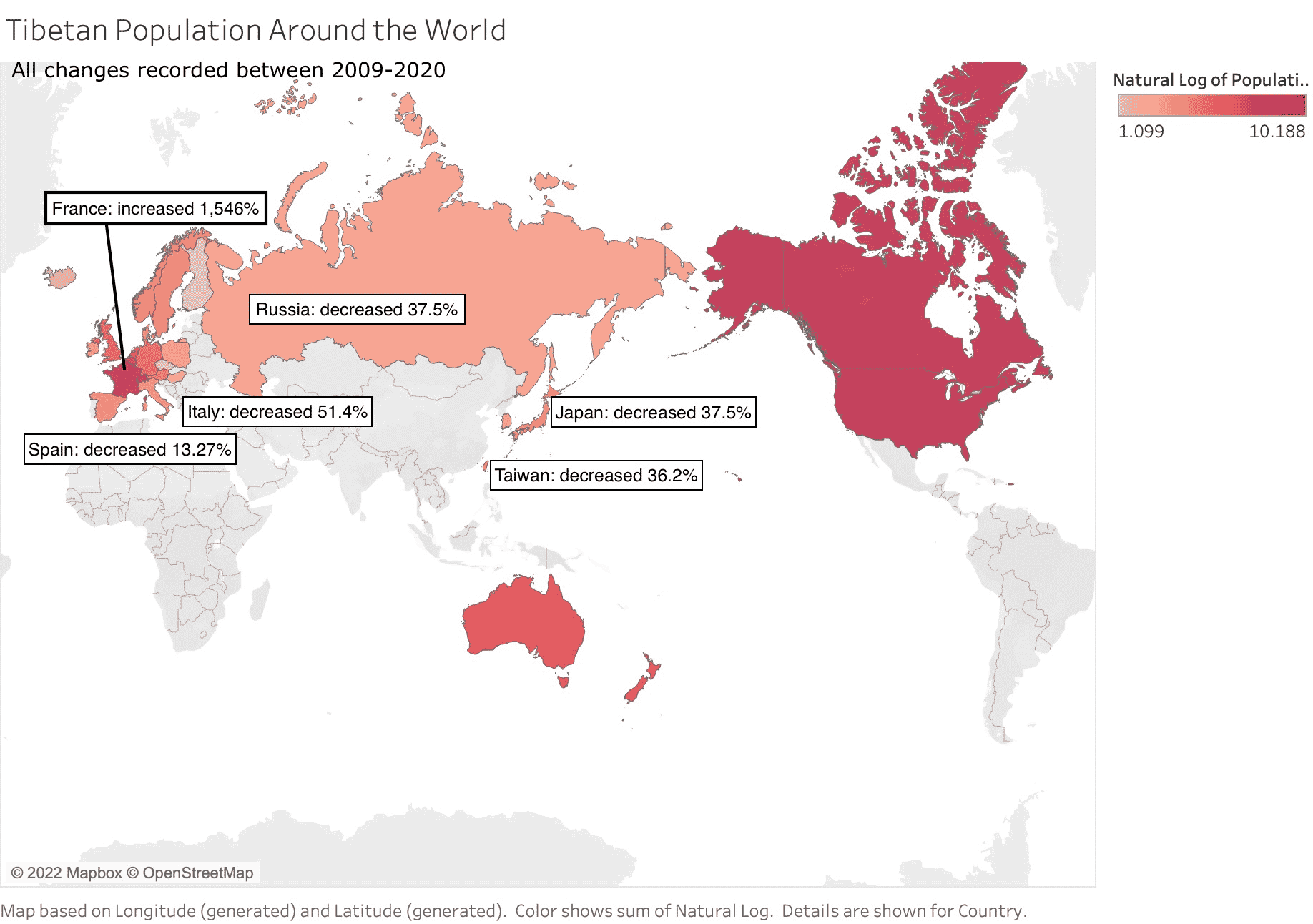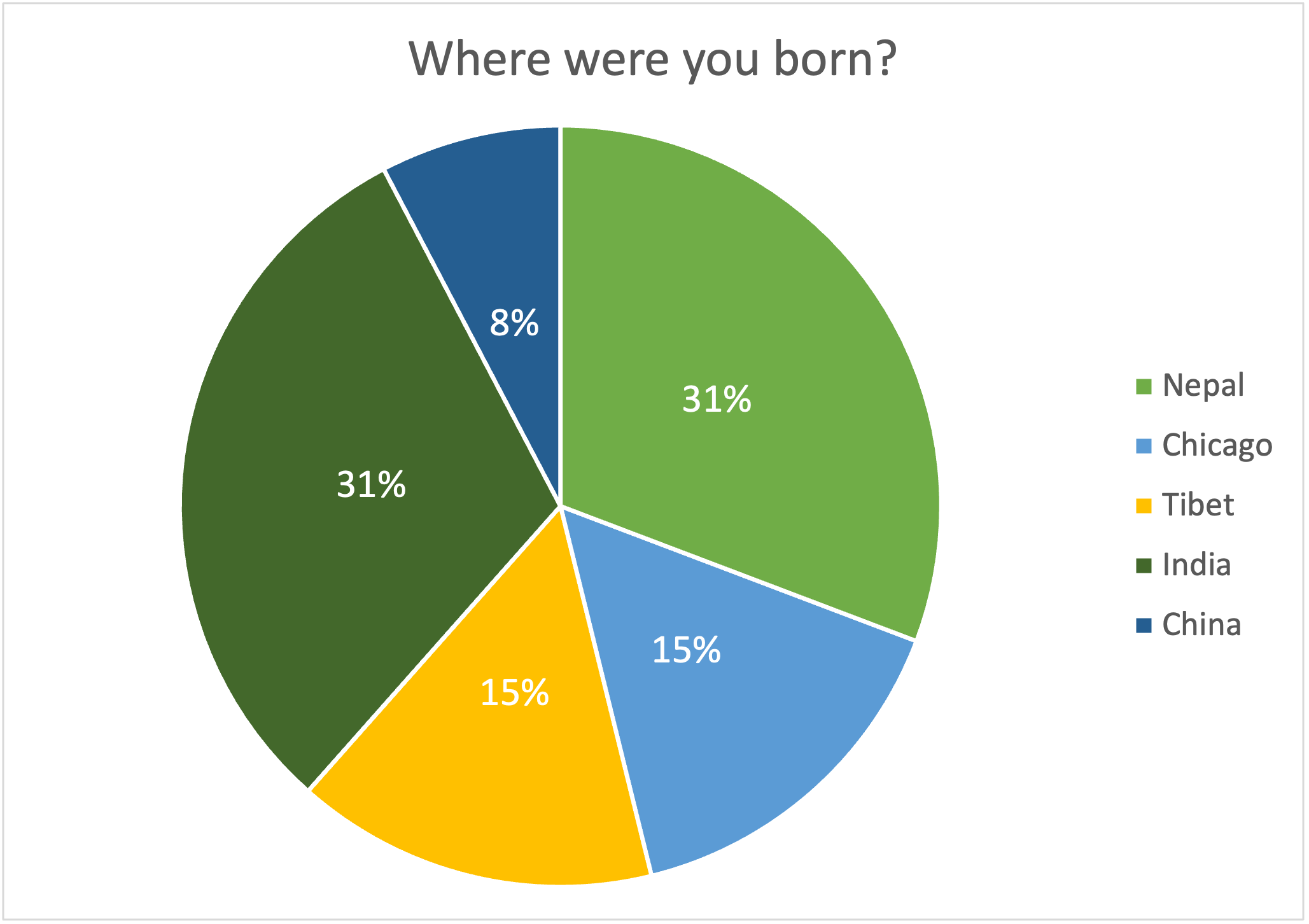Mapping Diaspora
Our research explored local and international population statistics, voting distributions, and Chicago-specific data on cultural locations and migrations via survey responses and statistics. Our data showcases the different migration and population patters of the Tibetan Diaspora as well as engagement with Tibetan Culture and politics around the world.
US Population Map

This heat map was created using Tableau to represent population density of Tibetans in various states across the United States. The population data was also obtained from a 2020 study by the Central Tibetan Administration entitled “Baseline Study of the Tibetan Diaspora Community outside South Asia. Data about the proportion of Tibetans living in that region is highlighted.
Note: The population data used to create this map was transformed with a natural log to improve the visualization. The numbers in the key reflect this log transformation.
World Population Map

This heat map was created using Tableau to represent population density of Tibetans in western countries outside the traditional Tibetan exile communities. The population data was obtained from a 2020 study by the Central Tibetan Administration entitled “Baseline Study of the Tibetan Diaspora Community outside South Asia. Hovering over select countries will reveal interesting data about population change and proportions.
Note: The population data used to create this map was transformed with a natural log to improve the visualization. The numbers in the key reflect this log transformation.
Chicago Map
Created using Google My Maps, the Chicagoland Tibetan Cultural Locations Map shows various cultural and religious locations wherein members of the local Tibetan diaspora connect with each other, their culture, and their religion. Included in the map are two Dharma Centers, one in Des Plaines, IL, and another in Prospect Heights, IL, as well as the Buddhist Temple of Chicago and the Tibetan Alliance of Chicago’s Evanston location. For each location marked on the map, there is a small paragraph describing the central ideas and basic information regarding its connection to the Tibetan diaspora and how it represents a portion of Tibetan culture. To find out more information about each of these locations, please visit the links to their websites located in the pop-up for each site!
Surveying the Diaspora
When beginning our research the group took a two-fold approach. We conducted both in person empirical research, in the form of a survey, as well as an informational analysis of various demographics. The purpose of our research was to study how members of the Tibetan community in Chicago identify themselves as a part of the Tibetan diaspora. More specifically the group focused on migration patterns, connections within the Tibetan community (both in Chicago and abroad), voter participation, and overall participation in issues/communal events that pertain to the Tibetan community as a whole.
In the survey that our group conducted some of the questions that were asked include:
- Where and when were you born?
- What year did you move to Chicago?
- What year did you move to the United States?
- What is your cultural/ethnic identity?
- Where/When did you feel the closest connection to your cultural/ethnic identity?
- Where/How do you connect with the Tibetan community in Chicago
- In what ways do you connect with the TIbetan community outside of Chicago?
When conducting the survey members of our group visited the Tibetan Alliance of Chicago on several occasions to interact with members of the Tibetan community. The survey was completed on one of the group members’ devices and did not take more than twenty minutes to complete per response.
In our independent demographic analysis the group heavily relied on data that was provided by the Central Tibetan Administration (CTA). The Central Tibetan Administration acts as the de facto Tibetan government in exile that unifies the diaspora and helps to conduct judicial practices.
This data was used in the creation of the World Population map, US Population map, and Voting Map.

Four respondents self-identified as being from India, four said they were from Nepal, two said they were from Chicago and two more from Tibet, and one said they were from China.
Of the two respondents that self-identified as being from Tibet, one is from Lasa, the capital of the Tibet Autonomous Region in southwestern China, and the other is Ü-Tsang, also in the Tibetan Autonomous Region. The respondent that self-identified as being from China is also from the Tibetan Autonomous Region.


Another question asked “Where / when did you feel the closest connection to your cultural/ethnic identity?
Out of the four respondents from Nepal, one answered “Nepal, all the time.” Two said with fellow community members and/or in Chicago, and one said the United States, specifically noting “not Nepal” due to “no political freedom.”
Four respondents said they felt closest to their cultural/ethnic identity in India, although only two of these responses self-identified as being from India, whereas the other two self-identified as being from Tibet.
In total, four respondents answered with some variation of the local community center/in Chicago.
